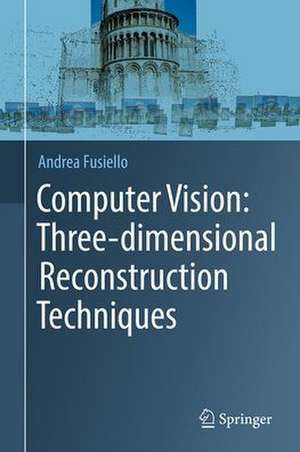Computer Vision: Three-dimensional Reconstruction Techniques
Autor Andrea Fusielloen Limba Engleză Hardback – 3 ian 2024
This text explores the theories and computational techniques used to determine the geometric properties of solid objects through images. It covers the basic concepts and provides the necessary mathematical background for more advanced studies. The book is divided into clear and concise chapters covering a wide range of topics including image formation, camera models, feature detection and 3D reconstruction. Each chapter includes detailed explanations of the theory as well as practical examples to help the reader understand and apply the concepts presented.
The book has been written with the intention of being used as a primary resource for students on university courses in computer vision, particularly final year undergraduate or postgraduate computer science or engineering courses. It is also useful for self-study and for those who, outside the academic field, find themselves applying computer vision to solve practical problems. The aim of the book is to strike a balance between the complexity of the theory and its practical applicability in terms of implementation. Rather than providing a comprehensive overview of the current state of the art, it offers a selection of specific methods with enough detail to enable the reader to implement them.
Preț: 541.35 lei
Preț vechi: 676.68 lei
-20% Nou
Puncte Express: 812
Preț estimativ în valută:
103.60€ • 107.76$ • 85.53£
103.60€ • 107.76$ • 85.53£
Carte tipărită la comandă
Livrare economică 12-26 aprilie
Preluare comenzi: 021 569.72.76
Specificații
ISBN-13: 9783031345067
ISBN-10: 3031345061
Pagini: 338
Ilustrații: XXIV, 338 p. 120 illus., 88 illus. in color.
Dimensiuni: 155 x 235 mm
Greutate: 0.69 kg
Ediția:1st ed. 2024
Editura: Springer International Publishing
Colecția Springer
Locul publicării:Cham, Switzerland
ISBN-10: 3031345061
Pagini: 338
Ilustrații: XXIV, 338 p. 120 illus., 88 illus. in color.
Dimensiuni: 155 x 235 mm
Greutate: 0.69 kg
Ediția:1st ed. 2024
Editura: Springer International Publishing
Colecția Springer
Locul publicării:Cham, Switzerland
Cuprins
Foreword.- Preface.- Acknowledgements.- Introduction.- Fundamentals of Imaging.- The Pinhole Camera Model.- Camera Calibration.- Absolute and Exterior Orientation.- Two-view Geometry.- Relative Orientation.- Reconstruction from Two Images.- Nonlinear Regression.- Stereopsis: geometry.- Stereopsis: matching.- Renge Sensors.- Multiview Euclidean Reconstruction.- 3D Registration.- Multiview Projective Reconstruction and Autocalibration.- Multi-View Stereo Reconstruction.- Image-based Rendering.- A Notions of linear algebra.- B Matrix Differential Calculation.- C Regression.- D Notions of Projective Geometry.- D Math Lab code.- Index.
Notă biografică
Andrea Fusiello has been teaching computer vision since 2000, first at the University of Verona and then at the University of Udine, where he is currently Professor of Computer Science. He has published more than 180 papers on these topics, and in 2011 he co-founded a start-up company that applies computer vision in the field.
Textul de pe ultima copertă
From facial recognition to self-driving cars, the applications of computer vision are vast and ever-expanding. Geometry plays a fundamental role in this discipline, providing the necessary mathematical framework to understand the underlying principles of how we perceive and interpret visual information in the world around us.
This text explores the theories and computational techniques used to determine the geometric properties of solid objects through images. It covers the basic concepts and provides the necessary mathematical background for more advanced studies. The book is divided into clear and concise chapters covering a wide range of topics including image formation, camera models, feature detection and 3D reconstruction. Each chapter includes detailed explanations of the theory as well as practical examples to help the reader understand and apply the concepts presented.
The book has been written with the intention of being used as a primary resourcefor students on university courses in computer vision, particularly final year undergraduate or postgraduate computer science or engineering courses. It is also useful for self-study and for those who, outside the academic field, find themselves applying computer vision to solve practical problems. The aim of the book is to strike a balance between the complexity of the theory and its practical applicability in terms of implementation. Rather than providing a comprehensive overview of the current state of the art, it offers a selection of specific methods with enough detail to enable the reader to implement them.
The book has been written with the intention of being used as a primary resourcefor students on university courses in computer vision, particularly final year undergraduate or postgraduate computer science or engineering courses. It is also useful for self-study and for those who, outside the academic field, find themselves applying computer vision to solve practical problems. The aim of the book is to strike a balance between the complexity of the theory and its practical applicability in terms of implementation. Rather than providing a comprehensive overview of the current state of the art, it offers a selection of specific methods with enough detail to enable the reader to implement them.
Caracteristici
Comprehensive guide to geometric computer vision, from image formation to 3D reconstruction Detailed explanations of the underlying algorithms, accompanied by clear and concise MATLAB code Accessible to readers with diverse backgrounds, including computer science, mathematics, and engineering
